Welcome to your guide to gardening vegetables 101, where I will walk you through the simple and easy steps to cultivate your own lush veggie garden at home. Starting a vegetable garden can seem overwhelming, but by following these basic steps, you can create a thriving garden in no time.
Key Takeaways:
- Choose the right spot for your garden based on factors like sunlight and soil drainage.
- Select the best fruits, vegetables, and herbs for beginners, considering your gardening zone and personal taste preferences.
- Feed the soil with organic matter to improve fertility and provide necessary nutrients for plant growth.
- Make efficient use of space by using raised beds instead of traditional rows and growing plants vertically.
- Maximize growing area and optimize soil health through crop rotation and planting in succession.
Choosing the Right Location for Your Garden
The first step in gardening vegetables 101 is choosing the right location for your garden. This step is crucial for the success of your vegetable plants, as the location can affect their growth and yield. When selecting the placement of your garden, there are several factors to consider.
| Factors to Consider: | Tips: |
|---|---|
| Space limitations | Determine if you have enough yard space or if you should opt for a container garden. |
| Ample sunlight | Choose a spot with at least 6 to 8 hours of direct sunlight, as most vegetables, fruits, and herbs require this amount of sun exposure to grow. |
| Protection from pests | Consider protecting your garden from pests by using natural pest deterrents or fencing. |
| Good soil and drainage | Ensure that the soil has good drainage and is rich in nutrients by adding organic matter, such as compost or manure. |
When determining the size of your garden, it is advisable to start small and expand as you gain more experience and time to tend to it. Different types of gardens, including planting in the ground, raised beds, or container gardens, require different sizes.
Finally, choose plants that grow well in your gardening zone and that you enjoy eating. Consider your gardening zone, the length of your growing season, and the amount of sun exposure your chosen spot receives when selecting plants for your garden. Some recommended beginner plants include tomatoes, salad greens, root vegetables, and cucurbits. Ultimately, the right location for your garden will provide enough sunlight, protect from pests, have good soil and drainage, and accommodate the size and types of plants you want to grow.
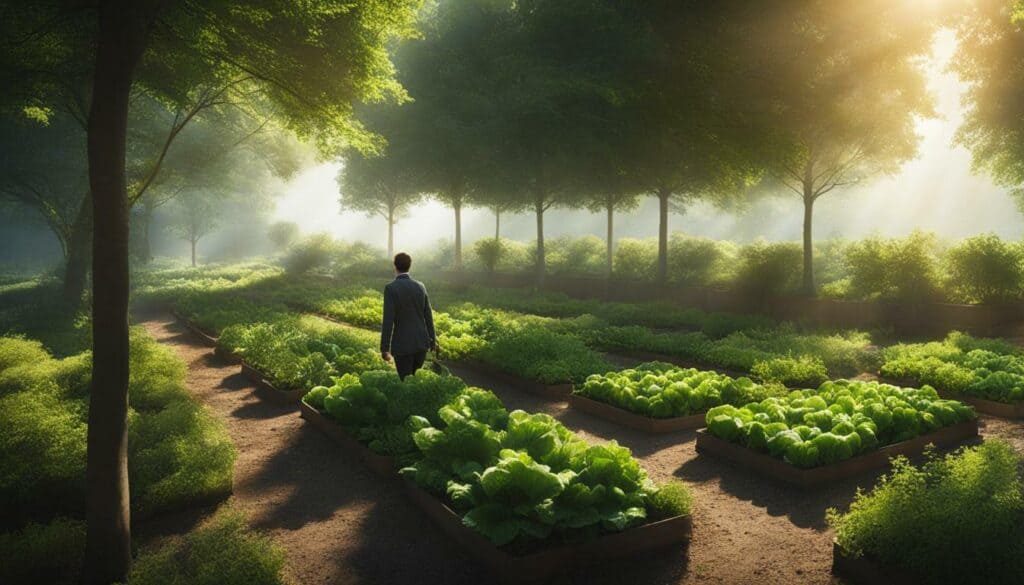
Remember: Planning is key to a successful vegetable garden. Take the time to choose the right location and size for your garden, and select plants that are well-suited to your gardening zone and personal tastes. With these simple tips, you’ll be on your way to a bountiful harvest in no time.
Determining the Size of Your Garden
Once you have chosen the location, it’s time to determine the size of your vegetable garden. Starting small and expanding as you gain experience is the recommended approach. For planting directly in the ground, a 10′ x 10′ plot is a good starting point, while raised beds measuring 4′ x 8′ or two 4′ x 4′ beds are suitable. Container gardens should have sufficient depth based on the plants being grown. Keep in mind that you will also need to consider space for pathways.
When selecting fruits, vegetables, and herbs for your garden, choose plants that you enjoy eating and that will thrive in your gardening zone and the specific spot you’ve chosen. Your garden zone and sun exposure are major factors that will affect the success of different plants. It is also important to pick plants based on your availability to tend to them.
Some recommended starter plants for beginner gardeners include tomatoes, salad greens, root vegetables, and cucurbits. These plants are relatively easy to grow and can produce a good yield with minimal effort.
Good soil with ample drainage is essential for plant growth. Organic matter, such as compost, should be added to the soil to improve fertility and provide nutrients for plants. Raised beds and trellises help maximize space in the garden and can make maintenance easier. Crop rotation and succession planting are techniques that can be used to make the most of the garden space and ensure continuous harvesting throughout the growing season.

By considering these factors, you can create a vegetable garden that is the right size for your needs and preferences, while also ensuring that your plants have the best chance of success.
Selecting the Best Fruits, Vegetables, and Herbs for Beginners
Now that you have determined the size of your garden, it’s essential to select the best fruits, vegetables, and herbs that are suitable for beginners. When choosing plants for your vegetable garden, it is important to consider multiple factors such as the space available, sunlight exposure, pest protection, and soil quality. Starting small and gradually expanding your garden is a wise decision, especially for beginners.
Tomatoes are one of the most popular plants to grow for beginner gardeners. They require full sun and grow well in raised beds or containers, making them an excellent option for small gardens. Salad greens, such as lettuce, spinach, and arugula, are another great choice for beginners. They grow quickly and are easy to maintain, requiring minimal space and sunlight.
Root vegetables such as carrots and beets are also easy to grow and do not require much care. Cucurbits, such as zucchini and cucumbers, are also beginner-friendly and can produce a bountiful harvest with proper care.
When selecting plants for your vegetable garden, it is important to consider personal taste preferences and gardening zones. Additionally, considering the specific spot chosen for the garden can help determine which plants will thrive in that location.
In addition to plants, it is important to have the necessary tools and supplies for gardening, including soil, seeds or starter plants, tomato cages, rake, hoe, garden hose, shovel, and hand tools.
To maximize space and make gardening more manageable, consider raised beds or containers. Organic matter, such as compost, should be used to improve soil fertility and provide nutrients for the plants. Proper crop rotation and succession planting can help maximize growing area and ensure healthy plants.
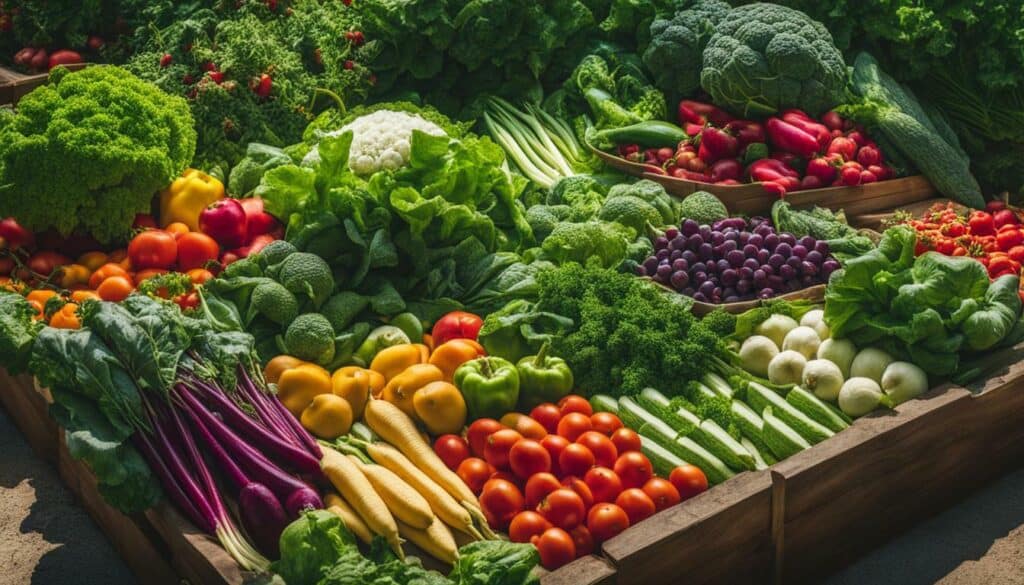
Selecting the right plants is crucial for success when starting a vegetable garden. It may take some trial and error to determine which plants are most suitable for your garden, but with patience and persistence, you will be able to grow a variety of fruits, vegetables, and herbs to enjoy at home.
Considering Your Gardening Zone and Preferred Tastes
When choosing plants for your vegetable garden, it’s crucial to consider two factors: your gardening zone and the plants you enjoy eating. Your gardening zone determines which plants will thrive in your climate, while your preferred tastes dictate the fruits, vegetables, and herbs you want to grow.
When choosing a spot for your garden, consider factors such as space limitations, sunlight exposure, protection from pests, and soil quality. Start with a small garden and gradually expand as you gain experience.
It’s also important to choose the right plants based on your zone and the amount of sunlight your chosen spot receives. Tomatoes, salad greens, root vegetables, and cucurbits are recommended for beginner gardeners.
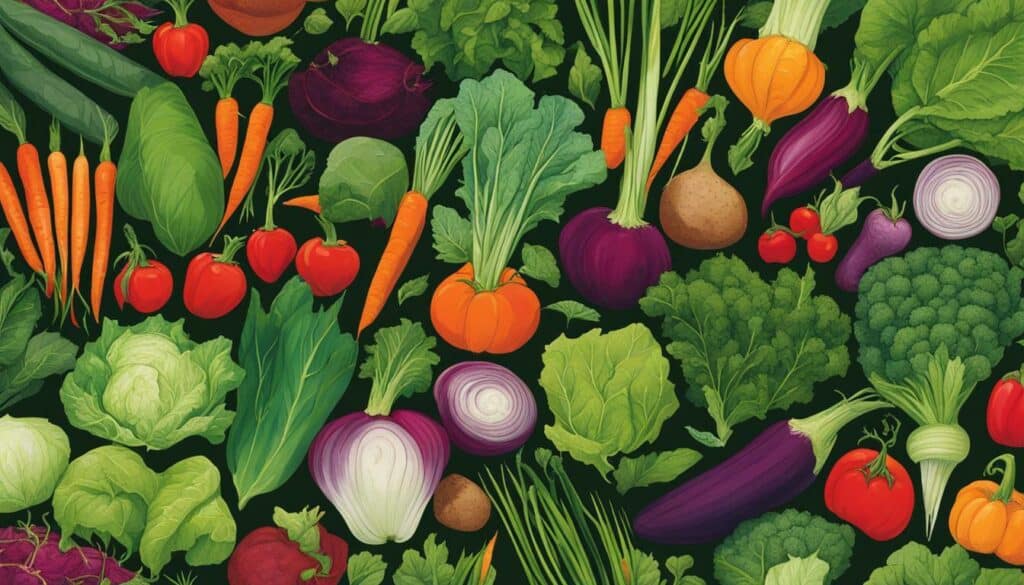
To maximize space, consider using raised beds and trellises. Additionally, make use of crop rotation and succession planting to ensure a continuous harvest.
By considering your gardening zone and preferred tastes, you can create a thriving vegetable garden that suits your needs and preferences.
Choosing the Right Spot for Your Vegetable Garden
The success of your vegetable garden relies heavily on choosing the right spot. When selecting a location, consider the amount of space you have available, the amount of sunlight the spot receives, protection from pests, and the quality of the soil. Ensure that the location you choose has ample sunlight, at least 6 to 8 hours of direct sunlight for most vegetables to thrive. Additionally, make sure the soil in the chosen spot has good drainage and is nutrient-rich.
If you have limited space, consider starting with a small garden and expanding as you gain experience. Raised beds and container gardens are great options for those with limited space. When deciding on the size of your garden, choose vegetables that you enjoy eating and that thrive in your gardening zone and specific garden plot. You can check your gardening zone for the length of your growing season and the risks of frost, which will help you choose appropriate plants.
| Plants for Beginners | Availability | Preferred Soil Type |
|---|---|---|
| Tomatoes | High | Well-draining soil |
| Salad Greens | High | Moist soil |
| Root Vegetables | Low | Sandy soil |
| Cucurbits (Cucumber, Squash, Melons) | High | Well-draining soil |
Some recommended plants for beginners include tomatoes, salad greens, root vegetables, and cucurbits. It’s also important to choose varieties that you can tend to based on your availability. When selecting your plants, consider your gardening zone, the length of your growing season, and the risks of frost.
Finally, maintaining a healthy soil by adding organic matter is crucial for successful vegetable gardening. A proper garden layout, such as using raised beds and trellises, and practicing crop rotation and succession planting can maximize your garden space and ensure a continuous harvest throughout the growing season.
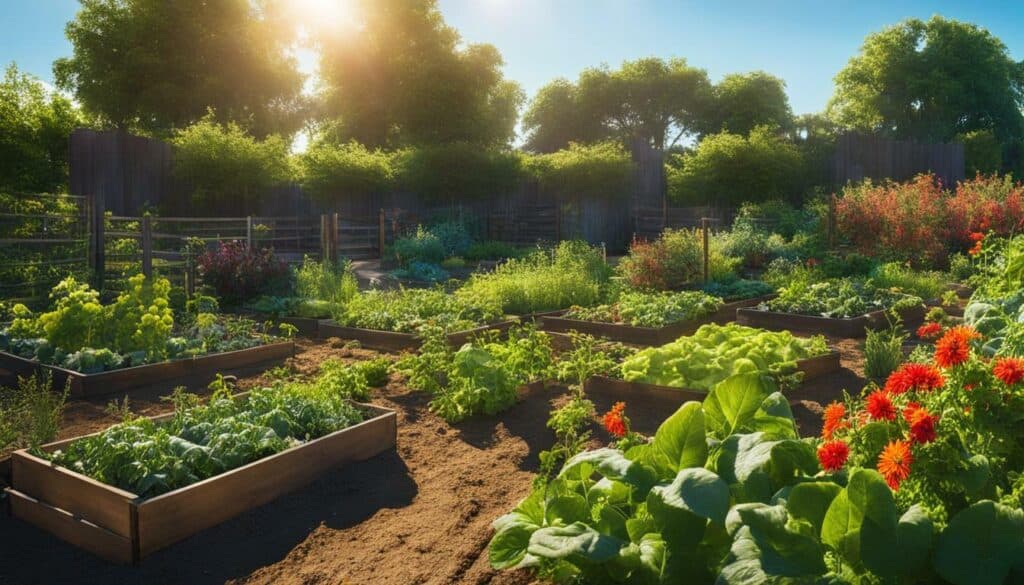
Preparation of the Garden Area
Before planting, it is essential to prepare the garden area properly. Choosing the right location is key; ensure there is enough space for your garden, ample sunlight exposure, protection from pests, and good soil with proper drainage. Clear out any weeds, debris, and rocks from the area where you plan to grow your vegetables.
| Steps for Preparing Garden Soil |
|---|
| Step 1: Loosen the soil to create a tilth, which allows roots to penetrate and absorb nutrients. A garden fork is useful for this task. |
| Step 2: Add organic matter such as compost to improve soil fertility and provide nutrients for vegetables. Spread a layer of 2-3 inches of compost over the soil and till it in. |
| Step 3: Test the soil pH with a soil test kit, which can be purchased at a garden center or online. Adjust the pH level if necessary, following the instructions on the kit. |
| Step 4: Adding a layer of mulch to the garden bed can help retain moisture and reduce weed growth. Options include straw, dried leaves, or wood chips. |
By clearing out space for an in-ground garden and amending the soil with organic matter, you will create an environment that will promote healthy and productive growth for your vegetables. Raised beds are an excellent alternative for gardening when space is limited. They offer an efficient use of space and are easier to manage. You can build raised garden beds from various materials such as wood, stone, or brick.

Trellising and crop rotation are additional techniques that can maximize space and protect plants. Trellising uses a structure to support climbing vegetables such as cucumbers, peas, and tomatoes, making vertical use of the garden area. Crop rotation can help to prevent the buildup of soil-borne diseases and pests that can occur when planting the same vegetables in the same spot every year. By rotating crops and planting in succession, you can ensure a continuous harvest throughout the growing season.
Starting Your Vegetable Garden in Spring
Timing is crucial when it comes to starting your vegetable garden. While spring is the perfect time to get your garden started, it is important to consider the last frost date for your gardening zone. Choosing the right location for your garden is also important. Find a spot that gets at least 6 to 8 hours of direct sunlight per day and is protected from pests. The area should also have good soil with adequate drainage.
Determining the size of your garden is crucial to avoid feeling overwhelmed. Experts recommend starting small and expanding as you gain experience. For planting directly in the ground, a 10′ x 10′ plot is recommended. Raised beds are another option, with a suggested size of 4′ x 8′ or two 4′ x 4′ beds. When opting for container gardening, choose containers with sufficient depth for the plants.
Selecting the right fruits, vegetables, and herbs for your beginner garden is essential. Consider your gardening zone, as certain plants grow better in specific zones. Also, prioritize plants that you love to eat and can tend to based on your availability. Tomatoes, salad greens, root vegetables, and cucurbits like cucumbers and squashes are great options for beginner gardeners.
To get started, gather the necessary gardening tools and supplies, such as soil, seeds or starter plants, tomato cages, rake, hoe, garden hose, shovel, and hand tools. Prepare the garden area by clearing out space and amending the soil with organic matter like compost. Consider the last frost date in your gardening zone when starting your garden in spring.
Raised beds can be a beneficial choice for efficient use of space in your vegetable garden. They eliminate ground weeds, prevent soil compaction, provide excellent drainage, and require less effort to maintain. Trellising is also recommended to maximize space by growing crops vertically. Crop rotation and succession planting help maintain soil health and ensure a continuous harvest throughout the growing season.

Whether you are a seasoned gardener or just starting out, starting your vegetable garden in spring requires careful planning and consideration of various factors. By following these simple steps, you can enjoy a bountiful harvest of fresh, healthy, and delicious fruits and vegetables.
Efficient Use of Space with Raised Beds
If you want to make the most efficient use of space in your vegetable garden, consider using raised beds. Raised beds are a great way to maximize your growing area while minimizing the amount of space needed for paths between the plants. By using raised beds, you can easily create a garden that is both beautiful and productive, with plenty of space for your favorite crops.
Converting from traditional row planting to raised beds of about 3-4 feet wide eliminates the need for multiple rows and paths, freeing up more square footage for growing crops. This not only maximizes the available space in your garden but also makes it easier to manage your plants, as you can easily reach all the plants without having to step on the soil.
Trellising is another effective technique for utilizing vertical space in the garden. By providing physical support to climbing vegetables like peas and pole beans, you can grow more crops without taking up additional ground space. This can be especially useful for small gardens, where space is at a premium.
Crop rotation is essential to maintain soil health and prevent nutrient depletion. By planting different crops in different areas of the garden each year, you can ensure that the same nutrients are not continuously used by the same plants. This helps maintain soil fertility and reduces the risk of soil-borne diseases.
Lastly, planting crops in succession throughout the growing season allows for a continuous harvest and avoids the overwhelming task of planting everything at once. By dividing the planting into smaller increments, you can make gardening more manageable and enjoy a steady supply of fresh produce.
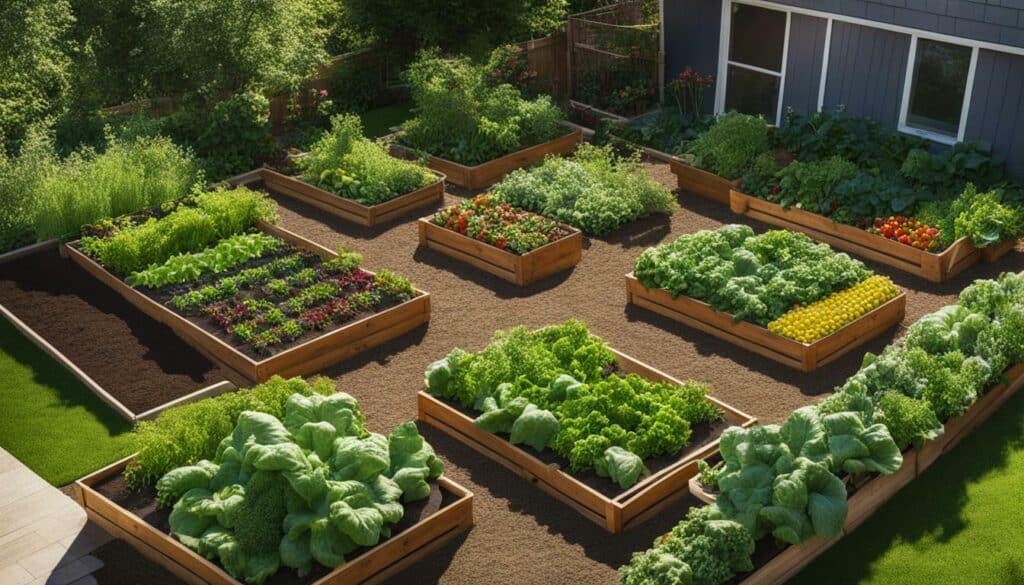
By using these techniques, you can make the most of the space you have available while growing a productive and healthy vegetable garden. Whether you have a large or small garden, raised beds and other efficient gardening techniques can help you grow more vegetables for your family to enjoy.
Maintaining Your Vegetable Garden
Once your vegetable garden is planted, it is crucial to take proper care to ensure a bountiful harvest. Proper maintenance involves choosing the right location and size for your garden, selecting the best plants for beginners, and taking proper care of your plants.
Feeding the Soil with Organic Matter
One of the most important aspects of maintaining a healthy vegetable garden is feeding the soil with organic matter. This helps to improve soil structure, increase nutrient levels, and promote healthy plant growth. Compost, aged manure, and leaf mold are excellent sources of organic matter that can be added to the soil on a regular basis.
Efficient Use of Space with Raised Beds
Another way to maintain a healthy vegetable garden is to make efficient use of space. Raised beds are an excellent option for small gardens, as they allow for more planting space and better drainage. They also make it easier to control soil quality and prevent soil erosion. Trellising is another space-saving technique that can be used for vining plants like tomatoes, cucumbers, and beans.
Rotating Crops
Crop rotation is an important technique that involves switching the location of crops from year to year. This helps to prevent soil-borne diseases and pests, while also improving soil health and nutrient availability. A simple rotation plan involves dividing your garden into four sections and planting different plant families in each section each year.
Planting in Succession
Planting crops in succession is another effective way to maintain a productive garden. This involves planting crops at different times throughout the growing season, so that they mature at different rates. For example, you could plant a row of lettuce seeds every two weeks, so that you have a continuous supply of fresh greens throughout the season.
Regular watering, weeding, and mulching are also important for ensuring healthy and productive plants. With the right care and attention, your vegetable garden can provide a bountiful harvest of fresh and delicious produce!
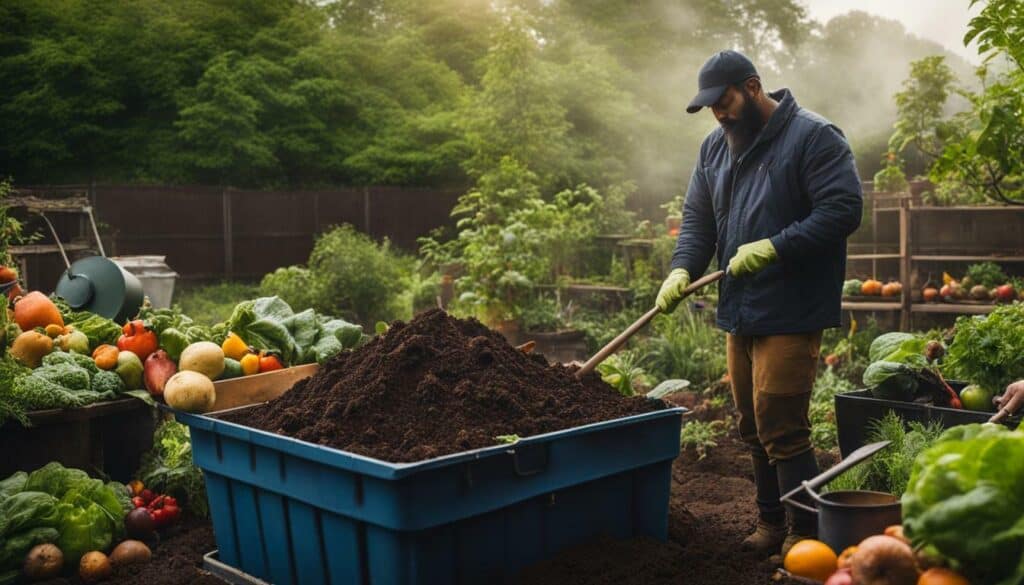
Conclusion
Congratulations! You now have the knowledge you need to start your journey into gardening vegetables 101. Starting a vegetable garden can be a rewarding and gratifying experience. Careful consideration should be given to choosing the location of your garden, as factors such as space limitations, sunlight exposure, and protection from pests can significantly impact your garden’s success. Determining the size of your garden based on your availability and the amount of time you can dedicate to tending to it is also important.
Choosing the right plants for your garden involves considering your gardening zone, personal taste preferences, and the specific spot you’ve chosen for your garden. The use of raised beds can be beneficial for efficient use of space and easy maintenance. Adding organic matter to your soil is essential for building and maintaining a healthy soil. It is recommended to convert from traditional row planting to raised beds or intensive gardening systems to maximize space. Trellising can provide additional vertical growing space.
Crop rotation and succession planting should be practiced to maintain soil fertility and ensure a continuous harvest throughout the growing season. By following these tips, you can successfully grow your own vegetables and enjoy the fruits of your labor. Remember, gardening is a continuous learning process, so don’t be afraid to experiment and try new things!
Thank you for reading this guide to gardening vegetables 101. We hope it has been informative and helpful in starting your own vegetable garden.
FAQ
Q: What are the simple and easy steps to gardening vegetables 101?
A: The simple and easy steps to gardening vegetables 101 include choosing the right location for your garden, determining the size of your garden based on availability, and considering the best fruits, vegetables, and herbs for beginners. It is important to select plants that you enjoy eating and that will grow well in your gardening zone.
Q: How do I choose the right location for my vegetable garden?
A: To choose the right location for your vegetable garden, pick a spot that receives full sun and is close to a water source. This will ensure that your plants get the necessary amount of sunlight and water to thrive.
Q: How do I prepare the garden area for planting vegetables?
A: Preparation of the garden area involves clearing out space for an in-ground garden and amending the soil with organic matter. Clear any weeds or debris and add compost or other organic materials to enrich the soil before planting.
Q: When should I start my vegetable garden?
A: It is best to start your vegetable garden in the spring after the last frost date for your gardening zone. This will give your plants the best chance of success and ensure they are not damaged by late frosts.
Q: How can I make efficient use of space in my vegetable garden?
A: Consider using raised beds in your vegetable garden to make more efficient use of space. Raised beds allow for better soil drainage and can be easily customized to fit the available space in your garden.
Q: How do I maintain a healthy vegetable garden?
A: To maintain a healthy vegetable garden, feed the soil with organic matter, rotate crops to prevent nutrient depletion, and plant in succession to have a continuous harvest throughout the growing season. These practices will help ensure the long-term health and productivity of your garden.
Source Links
- https://urbanfarmie.com/vegetable-gardening-101/
- https://ginghamgardens.com/vegetable-gardening/
- https://www.gardeners.com/how-to/vegetable-gardening/5069.html
- https://www.almanac.com/vegetable-gardening-for-beginners
- https://sebsnjaesnews.rutgers.edu/2020/04/choosing-the-right-location-for-your-vegetable-garden/
- https://melissaknorris.com/podcast/best-location-for-a-vegetable-garden/
- https://byf.unl.edu/veggie-gardeneing-101-site-selection
- https://todayshomeowner.com/lawn-garden/guides/choosing-the-right-size-vegetable-garden/
- https://www.bhg.com/gardening/vegetable/vegetables/planning-your-first-vegetable-garden/
- https://www.amazon.com/Fruit-Veggies-101-Gardening-Vegetables/dp/B0B5KNVXLF
- https://farmfitliving.com/raised-bed-gardening-101/
- https://www.gardeners.com/how-to/raised-bed-basics/8565.html
- https://www.planetnatural.com/raised-bed-gardening/
- https://gardening.ces.ncsu.edu/2020/03/vegetable-gardening-101-3/
- https://www.canr.msu.edu/news/smart-gardening-with-vegetables-101-growing-your-garden-tips
- https://byf.unl.edu/veggie-gardening-101-seeds-or-transplants





Leave a Reply